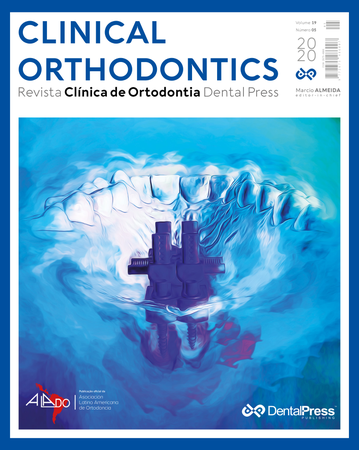Editorial Board
Autores: Marcio Rodrigues de Almeida,
messages.RevistaAutores:
LEIA MAIS
Opinion leaders, fact-checking and orthodontics
In a world that has been plagued by one of theworst pandemics ever seen before, that of Covid-19, questions remain despite its unfolding, bothpolitically and economically and socially. Theworld is currently experiencing, at least at thepolitical level, a dichotomous clash betweenthe population and...
Autores: Marcio Rodrigues de Almeida,
messages.RevistaAutores:
LEIA MAIS
Interview with Sam Daher
The first time I attended a performance by Dr. Sam Daher wasat an Align event in Las Vegas, about 10 or 11 years ago. At thetime, as Clinical Director of Brazil’s Align, I was taking a groupof Brazilian doctors to the Summit, a traditional congress ofthe company that took place biannually. I...
Autores: Marcos Janson, Carlos Alexandre Câmara, Mauricio Casa, Roberto Carlos B. Brandão,
messages.RevistaAutores:
LEIA MAIS
Why should first molar tubes be convertible?
INTRODUCTION: When assembling theorthodontic appliance there is a great variabilityof accessories. Each professionalchooses the most appropriate tubes andbrackets, as well as the type of bonding.However, although there are countlessways to achieve optimal results, one of thethings that can get...
Autores: Marcos Janson,
messages.RevistaAutores: Device assembly, Convertible tubes, Simple tubes, Orthodontic accessories, Finishing folds,
LEIA MAIS
Where to start smile esthetics treatment planning?
INTRODUCTION: Althoughthere are numerous publicationson smile esthetics, therealization of esthetic treatmentplanning in a simpleand systematic way is still achallenge. OBJECTIVE: To presenta step-by-step method on howto start an esthetic smile planningand answer the following questions:Where to...
Autores: André Wilson Machado,
messages.RevistaAutores: Dental Esthetics, Smiling, Orthodontics,
LEIA MAIS
The logic behind Tandem mechanics in alignment
INTRODUCTION: Tandemmechanics canbe used in orthodonticsto achieve toothalignment withoutoverloading the bracketsand their adhesion.OBJECTIVE: To describeand explain the advantagesof applying Tandem mechanics.CONCLUSION: The use of two NiTi arches in Tandemcan be cost-effective for the office,...
Autores: Renato Parsekian Martins,
messages.RevistaAutores: Orthodontic wires, Nickel-titanium, Orthodontics.,
LEIA MAIS
MARPE guide, from consolidation to technique evolution
INTRODUCTION: Digital orthodonticshas brought many benefits and some newchallenges, one example is the MARPE guide, whichhas several positive points already established andsome others that need to be evolved. The purpose ofthis paper is to present the evolution of MARPE guideand the precautions...
Autores: Cristiane B. André,
messages.RevistaAutores: Palatal Expansion Technique, Orthodontic Anchorage Procedures, cone-beam computed tomography,
LEIA MAIS
Mini-implant supported sliding-jig with multiple action for distal teeth movement
OBJECTIVE: The purpose of this paper is to presenta sliding jig with multiple functions. CONCLUSION:With this device it is possible to obtain optimizationof the orthodontic movement with a good biomechanicalcontrol.
Autores: Matheus Melo Pithon, Orlando Motohiro Tanaka, Rogério Lacerda Santos,
messages.RevistaAutores: Orthodontic appliance design, Orthodontic Anchorage Procedures, Orthodontics.,
LEIA MAIS
Class II, Division 1 Treatment of Patient with Hyperdivergent Growth Pattern and Mandibular Retrognathism: association of mandibular advancement appliance and miniscrews - Part 2
INTRODUCTION: The correction of Class II division1 malocclusion in patients with hyperdivergent growthpattern and mandibular retrognathism requires a differentapproach from the traditional treatment, which usually doesnot provide good results. OBJECTIVE: This article presentsa case report to...
Autores: Henrique Mascarenhas Villela,
messages.RevistaAutores: Class II malocclusion, Fixed functional appliance, Miniscrews, Hyperdivergent, Mini-implant,
LEIA MAIS
Late supernumerary teeth: one more problem to worry about
INTRODUCTION: Dental anomalies are challenges thatorthodontists may have to face when treating severalpatients. Supernumerary teeth, which represent about8-9% of all anomalies, do not seem to be associated withother shape, structure, size or position abnormalities.They have genetic-environmental...
Autores: Cesar Augusto Rodenbusch Poletto, Roberta Gevaerd, Taila Quatrin Nunes, Cleber Batassini, Ana Lurdes Conte,
messages.RevistaAutores: Supernaturais tooth, Dental anomalies, Orthodontics.,
LEIA MAIS
Treatment of Class II, Division 2 malocclusion with maxillary protrusion and insufficient space for maxillary canines by orthodontic camouflage: Case report
INTRODUCTION: Class II malocclusion is a common condition,and several factors are considered when choosingthe appropriate time for intervention and selecting the typeof treatment. METHODS: This case report describes theorthodontic treatment of a 9-year-old patient with AngleClass II, Division 2...
Autores: Klaus Barretto Dos Santos Lopes Batista, Bruno Moreira das Neves,
messages.RevistaAutores: Malocclusion, Angle Class II, Tooth extraction, Orthodontics, corrective,
LEIA MAIS
Modified Alt RAMEC protocol for early treatment of Class III with the DAFI Expander
INTRODUCTION: This paper aims to describe the stepsof the Modified Alt RAMEC Protocol for early correctionof Class III malocclusion, as well as to present acase treated by the proposed technique. The protocolis indicated for patients with skeletal Class III, due tomaxillary deficiency, in...
Autores: Wanderson Itaborahy, Rachel Itaborahy,
messages.RevistaAutores: Malocclusion, Palatal Expansion Technique, Angle Class III, Orthodontics.,
LEIA MAIS
The efficiency of the Biofunctional bracket prescription on the Class III malocclusion orthodontic treatment
OBJECTIVE: The aim of this study was to compare thecephalometric changes associated with the compensatorytreatment of skeletal Class III malocclusionpatients treatedwith anterior maxillary and mandibular torque alterations.METHODS: The sample consisted of 72 lateral cephalogramsof 36 patients...
Autores: Silvia Amelia Scudeler Vedovello, José Eduardo Prado De Souza, Pedro Andrade Júnior, Mário Vedovello Filho, Heloísa Cristina Valdrighi, Sara Azevedo Freire, Carlos Vinicius Da Silva Araújo, Carolina Carmo De Menezes,
messages.RevistaAutores: torque, Orthodontics, Malocclusion, Angle Class III,
LEIA MAIS
Tooth resorptions in orthodontic move
OBJECTIVE: To present a checklist of conducts to preventtooth resorption in orthodontic treatment, sincethey are predictable. RESULT: The list of 20 predictivefactors presented will help to avoid or control toothresorption in orthodontic clinical cases, and data mustbe collected and analyzed...
Autores: Alberto Consolaro,
messages.RevistaAutores: Root resorption, Tooth resorption, Tooth movement, Predictive factors, Iatrogenic,
LEIA MAIS
Treatment of Class I malocclusion with condyle fracture and mandibular asymmetry without orthognathic surgery
INTRODUCTION: Mandibular condylar fracture is oneof the most frequent fracture of the facial skeleton.However, the treatment of this condition remains acontroversial issue. The arguments were about an opensurgical treatment approach a versus conservativetreatment. OBJECTIVE: The present article...
Autores: Mariana Maciel Tinano,
messages.RevistaAutores: Facial asymmetry, Mandibular condyle, Orthodontics,
LEIA MAIS













.png)
